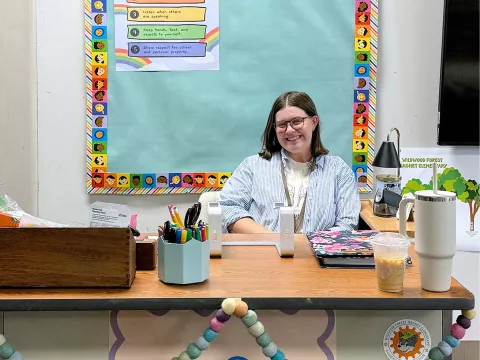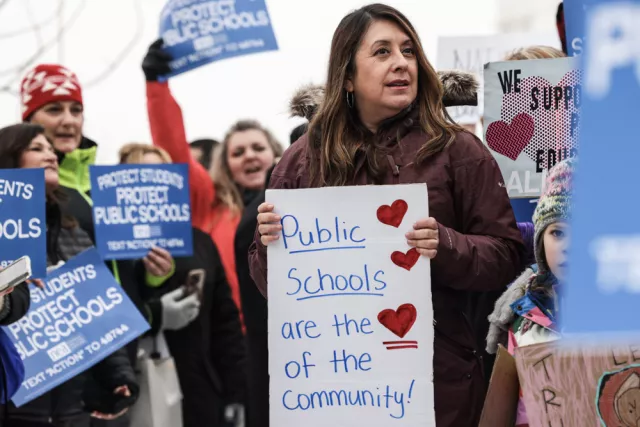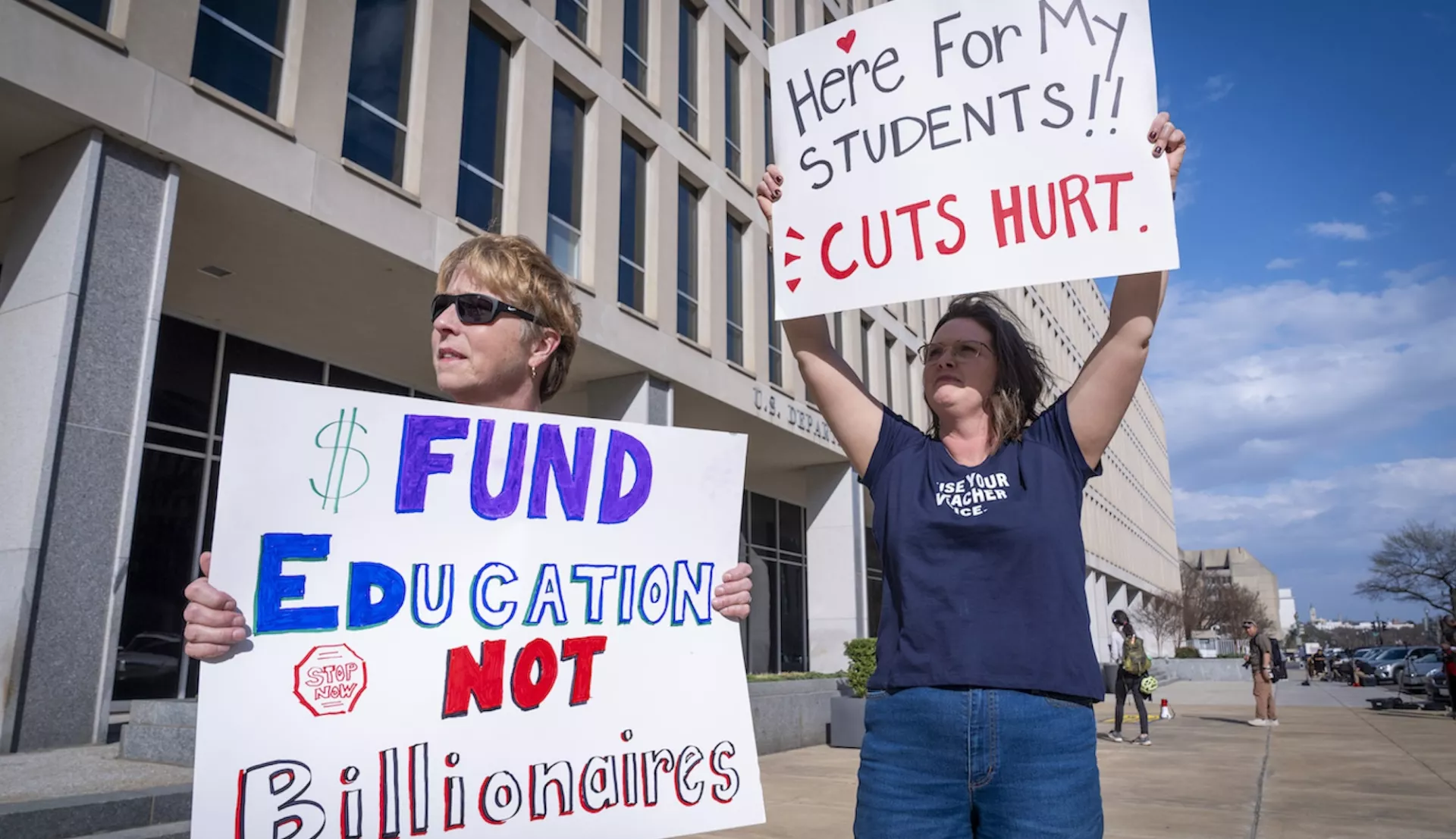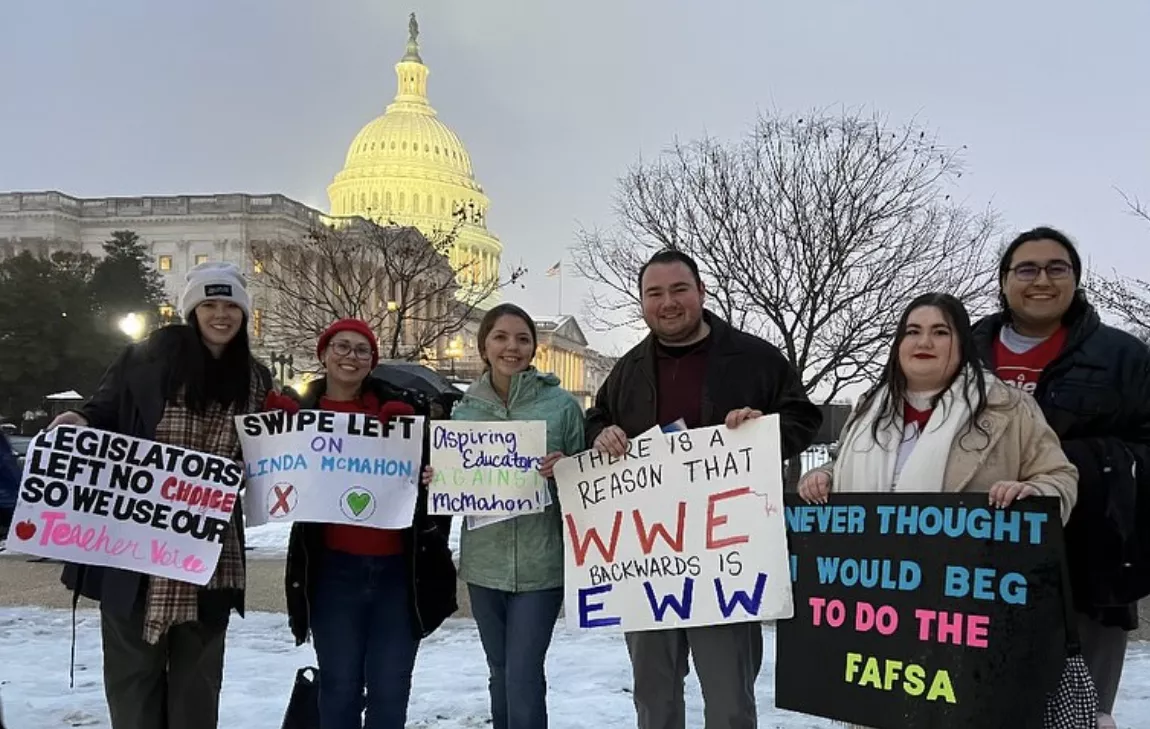Key Takeaways
- The Trump administration has cancelled millions of dollars in grants that supported teacher development across the U.S.
- These grants were created to reduce the national teacher shortage. They helped universities to recruit teachers and train them through teacher residency programs. They also paid for mentors, incentive bonuses, professional development, and more.
- While a federal judge ordered some of the teaching grants reinstated, the Trump administration appealed that ruling and last week the Supreme Court ruled the grants could remain canceled until the appeal is heard.
Teaching isn’t just a job for Kristen Terry. For 28 years, she says it has been her “ministry.” “This what I was born to do,” she says. “I know I was created to be a vessel to support and create change through teaching and facilitation.”

In her current job, in Raleigh, N.C., Terry doesn’t just teach her elementary students an innovative 21st century curriculum she developed. She also coordinates her school’s teacher-mentorship program, helping her most experienced colleagues support and retain new teachers. Or, in other words, Terry saves teachers.
This teacher-mentorship work is part of Wake County Public Schools’ Project LEADERS program, which was funded through a federal teaching grant. And now, it’s gone, another casualty of the Trump administration.
“My mind is just spinning,” says Terry. “We’re done. We can’t do it anymore. And that’s just sad.”
This spring, the Trump administration canceled more than $600 million in federal grants aimed at preparing—and retaining—teachers across the nation, but especially in poor and rural communities.
For decades, school districts, universities, and non-profits have used these grants to recruit teachers to colleges of education, to build effective teacher residency programs, to strengthen the certification and credentialing process, to support teacher-mentors and increase professional development, and more.
The grants were a rare federally funded response to the teacher shortage in public schools, a growing crisis that costs students every day. Many NEA members say grant-funded programs are the reason they’re in the classroom today—and doing the job well.
“We Won’t Be Silent”
Since taking office, President Donald Trump’s administration has terminated more than $1.5 billion in contracts and grants for congressionally authorized programs. In March, Trump also signed an order to abolish the Department of Education and his Secretary of Education Linda McMahon fired half its staff—a move that threatens millions of students with disabilities, rural students, and others. In response, NEA and NAACP have sued.
“We, the NEA, will always fight like hell when people come for our kids, our professions, and our communities,” said NEA President Becky Pringle.
To stop the grant cancellations specifically, eight Democratic-led states—as well as the American Association of Colleges of Teachers and the National Center for Teacher Residencies—filed two lawsuits against the Trump administration. In March, a federal judge ordered some grants reinstated. That included a $6.3 million grant to Minnesota’s St. Thomas University to produce 300 teachers, many of whom work as paraeducators or classroom aides.
“It’s weird that this is something that could be taken away,” student teacher Samuel Johnson told Minneapolis Public Radio.
The Trump administration appealed that decision and last week, the Supreme Court issued an emergency order (by a 5 to 4 vote) that the grants could remain cancelled while the case is appealed. This order applies to many, but not all of the grants. In a dissent, Justice Ketanji Brown Jackson said that allowing the grants to be terminated would “inflict significant harm on grantees — a fact that the government barely contests.”
The End of Something Good

In Wake County, the end of the grant might mean the end of Natalie Self’s teaching career at Raleigh’s Wildwood Forest Elementary School. Project LEADERS was the reason she moved from Texas to North Carolina.
Now that the Trump administration has canceled it, the 21-year-old is considering leaving after just one year—“which is crazy,” she told IndyWeek, “because just a couple weeks before this happened, I was completely planning on staying.”
The job is just too hard without the incentives and support provided by the grant, Self reported. Her students often come to school exhausted, wearing clothes that don’t match the weather. The grant helped teachers see the barriers to learning—and climb them. “They really made a space for us [teachers] to connect and feel seen and cared for…” she said.
The two dozen schools in Wake’s Project LEADERS are among the county’s neediest. At all of them, at least half the students live below the federal poverty line. Before the grant, all also had a teacher turnover rate of at least 20 percent—that is 1 in 5 teachers left every year, often for higher performing schools in the district. The constant instability and loss of experienced teachers has been a major challenge to student learning in those schools, Wake school officials reported in their grant application.
Since the project was established, however, teacher vacancies have dropped 40 percent in the Project LEADERS schools.
“This grant made a real difference for students,” Wake County school officials said in a statement. “It helped schools hire teachers faster, reduced vacancies, and improved hiring processes so more kids could start the school year with a full-time teacher in place. The program was effective, well-managed, and delivered real results.”
Not only did the grant provide mentors, it also paid for retention bonuses ($2,500), tuition reimbursement, and for teachers to go through national board certification (which costs nearly $2,000). These financial incentives matter in a state where the starting teacher pay is $40,136, or 42nd in the nation.
The grant also provided great professional development. For example, Terry studied classroom groupings and structures through Kagan that have transformed her teaching and improved learning and climate in her classroom. “The lifelong learner is not a cliché. That’s what is truly what I signed up to be,” says Terry.
The Point is the Teacher Shortage
The federal teaching grants all went to districts and states where it’s hard to recruit teachers—and nearly impossible to keep them. That includes rural and urban districts, ranging from Miami Dade to California’s Central Valley.
According to the latest research from the Learning Policy Institute, at a minimum, 406,964 teaching positions across the U.S. are unfilled or filled by uncertified people. That’s 1 in 8 teaching jobs and it means that hundreds of thousands of students don’t have a highly qualified, dedicated teacher to support their learning.
In South Carolina, public schools were short about 1,400 teachers at the start of the 2023 school year. To help with that issue, USC Beaufort had been using a $5.1 million grant—which is canceled now—to pay for two recruiters who promoted Beaufort’s teacher-prep programs to high school students and also a paid mentoring program that helped new teachers transition to the classroom.
Jessica Rye, a fourth-grade teacher in Beaufort, in her second year of teaching now, told the Post and Courier that her mentor was a “best friend.” That mentorship, as well as the professional development Rye received through the federal grant, helped her transition successfully from student to teacher.
“She was able to come into my room every single day last year and once a week this year to give me suggestions on my teaching practices,” Rye said. “It was very nice to have somebody who I felt was on my side without being an evaluative person as well.”
An Answer in Rural California
In the heart of California’s agricultural Central Valley, the Lindsay School District used to lose about 30 to 50 of its 200 teachers each year—or about 25 percent—and it struggled to replace them. Every school in the county is considered high-needs with the percentage of students living below the federal poverty line ranging from 87.5 to 90.4 percent.
Its answer? Since 2021, the Lindsay Residency Program has paired new student-teachers with experienced teacher-mentors. In just one year, those students get a master’s degree and teaching credential and deep instructional experiences. In return, they make a commitment to stay for at least four years.
“It was an intense program, but very worth it,” Lindsay teacher Sayla Arguelles told a local TV station last year.
Many of the teacher-residents, like Arguelles, have roots in Lindsay, which makes them less likely to leave for the state’s cities. “They know our families, our cultures…and what our learners are like,” said mentor teacher Kristy Caesar.
For their participation, the student-teachers get a $31,400 living stipend while their mentors were paid about $7,000 a year.
The residency program was funded through an $8 million federal teaching grant that also has been canceled.
“We have [union] members who really, really loved it and supported it,” says Lindsay Teachers Association President Andrew Camacho. “Overall, I think people are disappointed by the cancellation.”
Effects Across the Nation
The list of affected schools, students and educators goes on and on.
- In Arizona, a $16 million grant to three Phoenix districts was helping to grow and retain teachers. The cancellation means an expected $500,000 in teacher bonuses won’t get paid this year. “[Teachers] were counting on” on that money, note school officials. Meanwhile, Maricopa County schools also lost a similar $11.2 million grant. The money had been paying for 20 full-time teaching positions in 15 high-needs schools.
- In Milwaukee, a more than $3-million grant to Milwaukee Public Schools and the University of Wisconsin-Madison was helping students to get master’s degrees in special education while getting on-the-job training through a residency program. In Milwaukee, the teacher vacancy rate is as high as 1 in 5 in some schools, according to the Journal Sentinel, and half those vacancies are for special education teachers. U.S. Sen. Tammy Baldwin, D-Wisc., and others are demanding answers from the Trump administration.
- In Florida, a $7 million grant to the University of North Florida to strengthen the teacher pipeline to rural Clay County also was canceled. “It’s quite concerning, considering we’re in the midst of the worst teacher shortage we’ve ever seen in the state of Florida,” said Florida Education Association President Andrew Spar. Indeed, at the start of the school year, there were nearly 5,000 unfilled teaching jobs in the state’s public schools.






